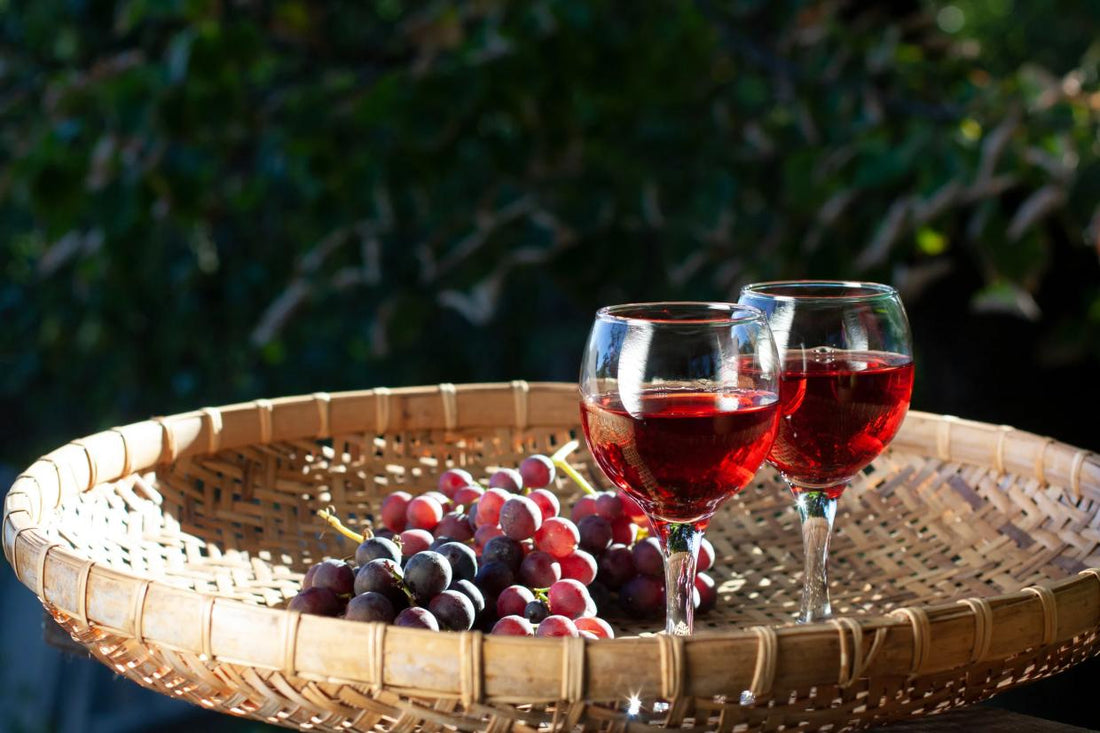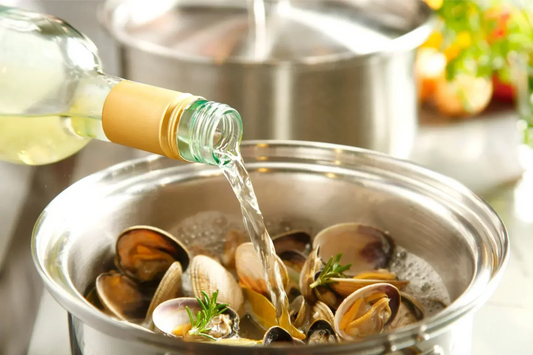
Light Red Wine Lovers’ Guide: 10 Delicious Types You Need to Try
Light red wine is becoming increasingly popular. With their fresh fruit flavours, low tannins, and a relaxed drinking style, these easy-going wines are ideal for any occasion. Whether you’re just getting into red wine or you’re already a fan, delving into light-bodied red wines unveils a whole new array of flavours and food pairings to explore.
What Is a Light Red Wine?
Light red wine typically describes red wines that feature lower tannin levels, a gentler colour, and moderate alcohol content, usually around 11-13%. These wines are often celebrated for their clarity, often showcasing ruby or garnet hues, alongside a bright acidity and delightful, fruity aromas.
Key Characteristics and How They Differ from Full-Bodied Reds
- Colour: Lighter and more transparent than dense, inky reds.
- Tannins: Softer, making them easier to drink, especially for new wine drinkers.
- Alcohol: Lower alcohol content contributes to a refreshing, less “hot” feel.
- Aromas & Flavours: Red fruits (cherry, strawberry, raspberry), florals, and occasional herbal or spicy notes.
- Body: Light and supple, without the heavy, mouth-coating sensation of fuller reds like Cabernet Sauvignon.
Types of Light Red Wine
Light red wines offer a diverse range of styles, each boasting a distinct charm. Whether you're in the mood for something fruity and floral or prefer a refreshing and vibrant sip, these wines are wonderfully versatile and enjoyable. Here are ten of the most popular light-bodied red wines. Discover their diverse flavours, origins, and perfect food pairings!
Pinot Noir

Ponit Noir is famous for its elegance and smooth texture, effortlessly combining vibrant red fruit flavours with delicate hints of earthiness and floral notes. Thriving in cooler climates, it has become a go-to choice for everything from casual drinks to fine dining experiences. Its gentle tannins and refreshing acidity make it a timeless option to pair with food.
🔍 Quick Facts
- Flavours: Cherry, raspberry, cranberry, earthy, floral
- Region: Burgundy (France), Oregon, California, New Zealand, Germany
- Food Pairings: Roast chicken, grilled salmon, mushroom risotto, soft cheeses
Gamay
Gamay, the shining star of Beaujolais, is renowned for its juicy red fruit, vibrant acidity, and an incredibly fresh taste. It’s often served slightly chilled, making it an easy-going wine that’s perfect for picnics, parties, or a laid-back dinner at home. With its low tannin profile, it’s a great choice for all palates.
🔍 Quick Facts
- Flavours: Strawberry, cherry, banana, violet, light spice
- Region: Beaujolais (France), Loire Valley, Switzerland, Oregon
- Food Pairings: Charcuterie, roast turkey, grilled fish, brie cheese
Grenache

Grenache is often celebrated for its juicy fruitiness, mellow tannins, and a hint of spice, resulting in wines that are smooth, generous, and enjoyable. Whether sipped solo or blended with other varietals, Grenache’s approachable character and lively flavours make it a choice for Mediterranean feasts and relaxed get-togethers.
🔍 Quick Facts
- Flavours: Strawberry, raspberry, red currant, white pepper, herbs
- Region: Southern Rhône (France), Spain, California, Australia
- Food Pairings: Grilled vegetables, barbecue, pizza, Mediterranean dishes
Cinsault
Cinsault offers a range of light and fragrant reds that burst with fresh berry notes and a lovely floral aroma. Its approachable style and low tannin levels make it perfect for sipping on sunny days or pairing with a variety of dishes. While you’ll often find it in southern France, Cinsault shines whether it’s in blends or enjoyed on its own.
🔍 Quick Facts
- Flavours: Red berries, rose petals, herbal, subtle spice
- Region: Southern France (Languedoc, Provence), South Africa, Lebanon
- Food Pairings: Tapas, salads, grilled chicken, couscous
Lambrusco
Lambrusco is a vibrant, sparkling red wine from Italy that has won over many fans thanks to its refreshing bubbles and fruity notes. It comes in a range of styles, from dry to just a touch sweet, making it a brilliant choice for pairing with food or celebrating special occasions. With its fun and lively personality, Lambrusco is sure to please any crowd!
🔍 Quick Facts
- Flavours: Strawberry, blackberry, cherry, sometimes a subtle earthy note or a touch of tartness
- Region: Emilia-Romagna (Italy)
- Food Pairings: Cured meats, pizza, fried foods, aged cheeses
Zweigelt
Zweigelt is Austria’s most beloved red grape, offering delicious berry flavours and a smooth mouthfeel, with a hint of spice to keep things exciting. Its lively character and soft tannins make it an easy choice for any occasion, whether you’re having a laid-back dinner or indulging in a hearty Central European feast.
🔍 Quick Facts
- Flavours: Cherry, raspberry, black pepper, floral
- Region: Austria, Hungary, Czech Republic
- Food Pairings: Roast pork, sausages, grilled vegetables, schnitzel
Frappato
 Frappato from Sicily is an incredibly aromatic and vibrant wine, celebrated for its fresh notes of strawberry, pomegranate, and a hint of herbs. With its bright and playful palate, along with soft tannins, it’s a fantastic pairing for light Italian dishes or alfresco summer meals.
Frappato from Sicily is an incredibly aromatic and vibrant wine, celebrated for its fresh notes of strawberry, pomegranate, and a hint of herbs. With its bright and playful palate, along with soft tannins, it’s a fantastic pairing for light Italian dishes or alfresco summer meals.
🔍 Quick Facts
- Flavours: Strawberry, pomegranate, herbs, red pepper flakes
- Region: Sicily (Italy)
- Food Pairings: Tomato-based pasta, seafood, grilled eggplant, antipasti
Schiava (Vernatsch)
Schiava, known as Vernatsch in northern Italy, produces pale red wines. These wines are celebrated for their subtle fruit and floral aromas, finishing smoothly with a hint of nuttiness. Perfect for those who fancy something refined yet relaxed, they pair wonderfully with lighter meals or traditional Tyrolean fare.
🔍 Quick Facts
- Flavours: Cranberry, raspberry, almond, violet
- Region: Alto Adige (Italy), Trentino, Germany (as Trollinger)
- Food Pairings: Light Italian dishes, cured meats, fresh cheeses, trout
Trousseau
Trousseau is a little-known treasure hailing from the Jura region of France. It boasts bright acidity, tart red fruit, and just a hint of spice. This lively, medium-bodied wine is perfect for those adventurous drinkers who appreciate wines that strike a balance between energy and subtlety.
🔍 Quick Facts
- Flavours: Red currant, cherry, earthy, white pepper
- Region: Jura (France), Spain (as Bastardo), California
- Food Pairings: Smoked meats, duck, hard cheeses, mushroom risotto
Dolcetto
Although it might sound sweet, Dolcetto is quite dry and smooth, boasting luscious fruit flavours with a slight hint of bitter almond at the finish. This wine is a beloved staple in northern Italy, perfect for pairing with uncomplicated, hearty dishes, and it offers a charm that's just right for enjoying any day of the week.
🔍 Quick Facts
- Flavours: Black cherry, plum, liquorice, almond
- Region: Piedmont (Italy)
- Food Pairings: Pizza, pasta, salami, roast chicken
| Top 10 Light Red Wine Types: Flavours, Regions, and Food Pairings | |||
|---|---|---|---|
| Light Red Wine Type | Flavours | Key Regions | Best Food Pairings |
| Pinot Noir | Cherry, raspberry, cranberry, earthy, floral | Burgundy (France), Oregon, California, New Zealand, Germany | Roast chicken, grilled salmon, mushroom risotto, soft cheeses |
| Gamay | Strawberry, cherry, banana, violet, light spice | Beaujolais (France), Loire Valley, Switzerland, Oregon | Charcuterie, roast turkey, grilled fish, brie cheese |
| Grenache | Strawberry, raspberry, red currant, white pepper, herbs | Southern Rhône (France), Spain, California, Australia | Grilled vegetables, barbecue, pizza, Mediterranean dishes |
| Cinsault | Red berries, rose petals, herbal, subtle spice | Southern France (Languedoc, Provence), South Africa, Lebanon | Tapas, salads, grilled chicken, couscous |
| Lambrusco | Strawberry, blackberry, cherry, tartness, earthy | Emilia-Romagna (Italy) | Cured meats, pizza, fried foods, aged cheeses |
| Zweigelt | Cherry, raspberry, black pepper, floral | Austria, Hungary, Czech Republic | Roast pork, sausages, grilled vegetables, schnitzel |
| Frappato | Strawberry, pomegranate, herbs, red pepper flakes | Sicily (Italy) | Tomato-based pasta, seafood, grilled eggplant, antipasti |
| Schiava (Vernatsch) | Cranberry, raspberry, almond, violet | Alto Adige (Italy), Trentino, Germany (as Trollinger) | Light Italian dishes, cured meats, fresh cheeses, trout |
| Trousseau | Red currant, cherry, earthy, white pepper | Jura (France), Spain (as Bastardo), California | Smoked meats, duck, hard cheeses, mushroom risotto |
| Dolcetto | Black cherry, plum, liquorice, almond | Piedmont (Italy) | Pizza, pasta, salami, roast chicken |
How to Choose and Serve Light Red Wine
Choosing and serving light red wine can be quite easy. Here’s a simple guide on how to select a bottle, serve it perfectly, and keep it fresh after you’ve opened it.
Tips for Selecting Quality Bottles
- Look for trusted regions: Seek wines from regions famous for quality light reds, such as Burgundy (France), Beaujolais, Oregon, Alto Adige (Italy), and Austria.
- Check the grape variety: Choose popular light-bodied grapes like Pinot Noir, Gamay, Grenache, Cinsault, or Zweigelt.
- Mind the vintage: Opt for recent vintages (within the last 2-3 years) for freshness and lively fruit.
- Alcohol content: Bottles with lower alcohol (usually 11-13%) tend to be lighter and more refreshing.
- Read the label: Look for tasting notes like “fresh,” “fruity,” or “crisp,” which often indicate a lighter style.
Serving Temperature
Light red wines are best enjoyed when they’re slightly chilled. Aim for a serving temperature of around 10°C to 16°C (50°F to 60°F). Chilling them just enough brings out their vibrant fruit flavours, crisp acidity, and refreshing finish, whilst keeping any bitterness from the tannins at bay. To get that ideal chill, pop the bottle in the fridge for about 20 to 30 minutes before pouring. Just be cautious not to serve it too cold, as that can dull the wine’s aromas and flavours.
Want to know the ideal serving temperatures for every wine style? Check out our Wine Temperature Serving Guide for expert tips on how to make every bottle taste its best.
How Long Does Light Red Wine Last Once Opened?
Once opened, light red wines can stay fresh for around 2 to 3 days when stored correctly. Just remember to reseal the bottle tightly and place it in the fridge; this little step helps slow down oxidation and keeps the wine’s delicate flavours intact. After three days, most light reds might lose their vibrant character and could taste a bit flat.
Looking for more advice on keeping your wine fresh? Explore our full guide on How Long Does Wine Last After Opening? to get the most out of every bottle.
Conclusion
Light red wine is a refreshing and versatile choice for any occasion. It boasts vibrant fruit flavours, soft tannins, and an impressive ability to pair well with a variety of dishes. Whether you’re a newcomer to wine or simply on the hunt for something different, exploring various types of light red wine can lead to an enjoyable array of flavours. Just remember, the best light red wine is the one you enjoy the most, served exactly how you prefer it.
FAQ
1. What is light red wine?
Light red wine is a type of red wine that's characterised by its lower tannins, a lighter hue, and moderate alcohol content, typically sitting between 11 and 13%. These wines shine with bright acidity and delightful fresh red fruit flavours that make them a perfect choice for casual sipping or pairing with lighter dishes.
2. What are the best types of light red wine?
Some popular types of light red wine that you might enjoy include Pinot Noir, Gamay, Grenache, Cinsault, Lambrusco, Zweigelt, Frappato, Schiava (also known as Vernatsch), Trousseau, and Dolcetto. Each offers a unique flavour profile worth exploring!
3. What foods pair well with light red wine?
Light red wine pairs well with a variety of dishes, including roast chicken, salmon, charcuterie, grilled vegetables, mushroom-based meals, pizza, and soft cheeses. Its bright acidity and fresh fruit notes lend versatility, making it an excellent companion for many culinary delights.



